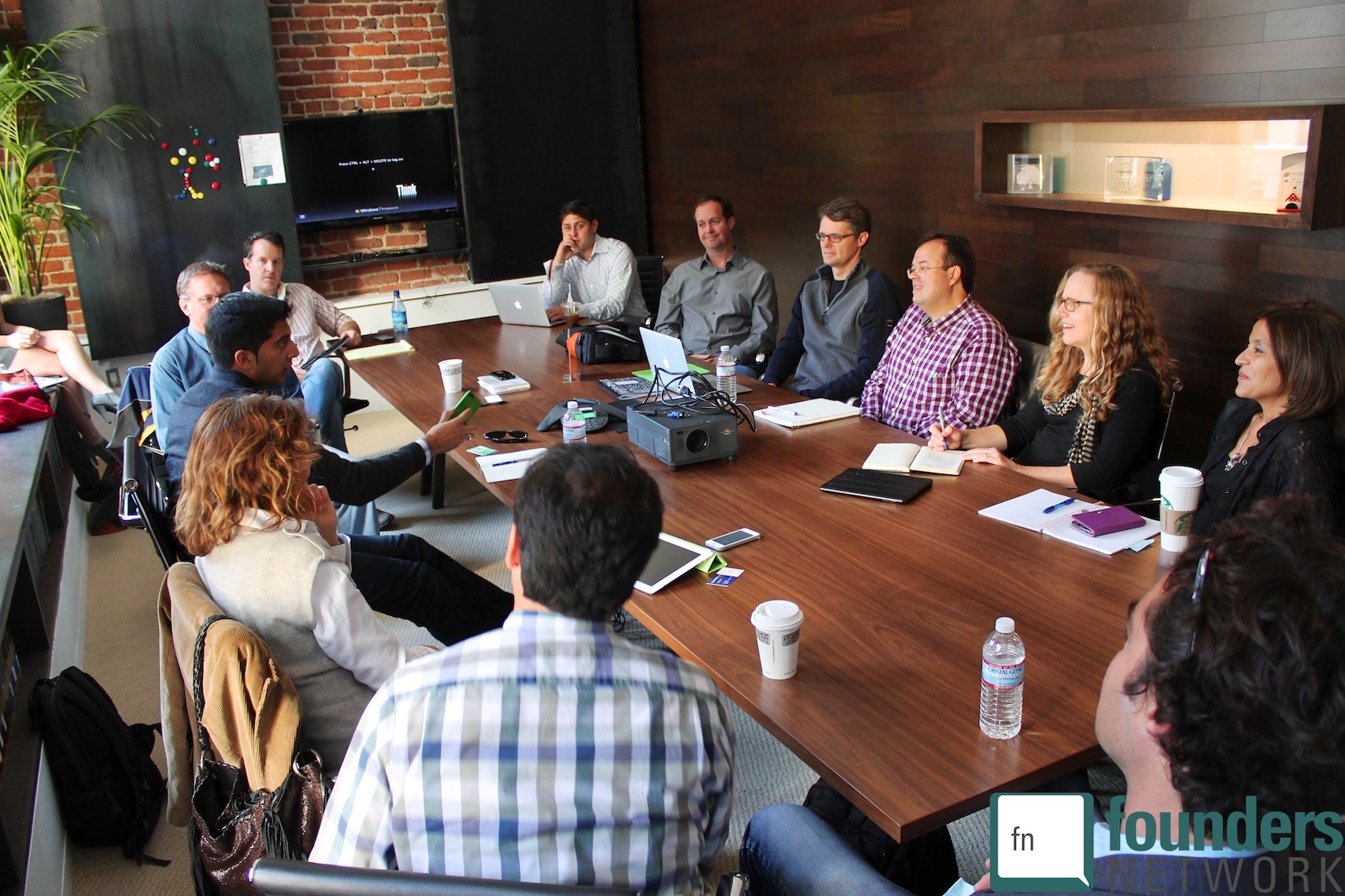
An impressive list of institutional and angel investors advised Founders Network members over the last year: VCs Howard Hartenbaum from August Capital, Annie Kadavy of Charles River Ventures and Noah Lichtenstein of Cowboy Ventures, and prolific angel investors Gil Penchina (Flight) and Jason Calacanis (Launch).
They’ve watched the best and the worst – and they’re willing to share some of that brutal feedback.
Whether it was headlining a mentoring event or offering one-on-one pitch feedback with members, they’ve each advised Founders Network members on what entrepreneurs need to figure out NOW – as in, ahead of time – to stand out to investors.
Here are the 6 tactics they say you need to nail before your 30 seconds in the elevator (or at the oyster bar, or crossing Market Street … )
Get an intro. Just do it.
Every founder feels like an outsider when they start. The world of investors can look like a closed system that’s hard to crack. That’s not totally unintentional.
“If you can’t get a warm intro to me, do you really have the hustle to get out there?” Lichtenstein asks. “If you’re going to sell a product, you need to find more strategic ways to reach people you’ve never met.”
Don’t despair. There’s a playbook, Lichtenstein points out. Groups like Founders Network have connections into the venture world. Go to meetups. Build rapport with partners like your lawyer or your accountant – often they’ll have a connection.
And don’t forget that introductions can start to build on each other.
“It’s all about social proof,” Penchina notes. “The more people you line up as advisors or investors who look legit, the more likely I am to believe that you ARE legit.”
“I don’t need to do too much research because when I get a referral, it is really vetted,” Calacanis says. “If I’m sitting at a poker table and Josh from DFJ says he has a founder who really wants to meet me, I wouldn’t just meet him. If it’s an incredibly beautifully designed product, I might think I’d invest, after one minute.”
Know your audience
Not every investor is looking for the same thing – and you had better know what they want before you start talking.
“The person on the other side of the table is going to see the world very differently depending on whether they’re an angel or or a seed or a series A investor,” Kadavy says.
An angel might be asking, do I like this person? Is the market big enough? Is it worth making a bet? They might make the decision right there in the meeting.
A series A investor has to ask, “do I want to be married to this company for the next 7-10 years?” There’s due diligence to do, and more digging into the tactical aspects of the business.
At Charles River Ventures, they’re looking to write fewer, larger checks for teams that have already raised a seed round.
“Making investments at this stage is about the relationships as much as it is about the product. You’re literally wedding yourself to the people on the other side.”
A founder needs to know a VC’s interests and scale before that first conversation. If you do your homework and reach out in an authentic way, people will want to help, Kadavy says.
“If you believe that there is an investor out there who is THE investor for you, tell them why.”
“The closer you can get to people with experience in your target segment or your product or your feature set the better, because you have less convincing to do,” Penchina says.
“There’s a bunch of tags people can put on their AngelList profile page saying what they’re interested in. I would find people in your sector who just became rich, and therefore think they’re smart – those people are great as angels, because they’re more likely to write checks.”
“If I were an entrepreneur, I would want a grinded out entrepreneur as my investor,” Calacanis says. “I know I can text them and they will talk me off a ledge, and explain the problem or at least be there for me.”
“The right investor can be the person standing at your side saying, ‘yeah, this thing could fly off the rails and be a zero – but that’s why we invested in you, because you could do something bold and fast,’” Calacanis says.
“As I told Elon Musk when we were having dinner back in those days, anybody who successfully got into orbit blew up rockets along the way.”
Know your numbers – and why they’re rock solid
Too many investors have been burned on the vague promise of “monetizing the data,” so if that’s your plan, be sure you can back yourself up, Hartenbaum says. Please remember: ‘data’ and ‘long tail’ are four letter words. Know your customer acquisition costs (CAC) and what fraction of your customer lifetime value (LTV) they represent.
Not every founder has to be an analytical whiz – but two out of five partners at a VC firm probably will be (or think they are). Know your audience, and demonstrate that you have real numbers and a solid grasp of what to do with them. Regardless of your product, key metrics are non-optional.
“Certainly, the scale for ‘interesting to venture’ on the consumer side has gone up,” Penchina says.
“Every mobile app has a million users now, so 10 million is the new bar for interesting. It makes sense when you figure there are a couple billion mobile internet users.”
Harsh, but not the end of the story. Queuing off downloads or percent increase week over week isn’t the right metric to show you’ve built a sticky product people love.
“There are teams out there that can get a million downloads in 4 weeks, and that’s not interesting to me,” Kadavy says. “There are a lot of ways to game the system. I’m interested in cohort data, which is something you can really only collect over time.”
“I would much rather see a company that had 200,000 subscribers and data on how they used the product for a month than a company that signed up a million subscribers in three weeks but no data on how they used the product.”
Show your work
It’s just like the old rule on math tests: you can’t just show a number, you’ve got to be able to explain how you got there. This is especially true if you’re looking for seed funding based mostly on potential, not delivered traction.
“The more you can demonstrate that you’ve thought these things through and can back them up, the more confidence investors will have in you,” Lichtenstein says. “We want to understand how you’re thinking, whether you’re making realistic assumptions.”
You’re going to be pitching against industry benchmarks – and whether you know them or not, the VCs definitely will. So do your homework and know what product-specific metrics your pitch will need, Lichtenstein says.
“There’s a lot of information out there – so before you stick your head down building building building, take a couple of hours to sit back and ask: what are the goal posts I want to set, and the key metrics I actually need to track?” Lichtenstein says.
Don’t wait until a VC asks for them to realize you’re missing data that’s standard to your sector.
“It’s less about the data that you have already, and more the framework for how you think about the data. How much does it cost you to acquire a user?”
You may not know yet – that’s part of why benchmarking is not optional. How much does it cost a comparable company? Why haven’t you run a small test, acquired a few users, and measured what it took?
“A lot of people say, I need to get the money to launch and prove something out – it’s a Catch 22. But you can demonstrate small indicators that this is going to work, that back up your projections.”
Ice the Cake
That tip above – about using small tests to backup all your predictions and projections of success – it’s a basic piece of legwork you can’t skip.
“It seems depressing to me that you need to raise money from me before you’ve convinced anyone to buy the product,” Penchina says. “Especially given how easy it is now to get on Kickstarter and show that there is actually latent demand for a new product.”
“You can validate my fear that no one wants the shit you’ve built,” as Penchina puts it.
“It seems kind of a dumb statement, but it’s about how much icing you can put on the cake. The more icing you have, the more interested people are.”
Founders have to show more data and more traction than they use to, and at very early stages – but that’s partly because the cost to do so has gotten so low.
“It’s embarrassing to show up without it,” Penchina says. “It takes $500 or $5,000 to put up a website, a/b test it and buy some google ads. Figure out your funnel and your viral coefficient. Show me something that makes your idea better than the other 50 PowerPoints I saw with no data.”
Just showing that people are willing to use your product is worth a lot. Usage beats no usage, and usage with revenue beats usage. Demonstrate that your product doesn’t need funding to survive – it needs funding to accelerate growth.
“We’re all optimists who are going to be skeptical,” Hartenbaum says. There is nothing like success to silence the skeptics.
Remember that “no” is not the end
Rejection is a bitch. You’re going to go to VCs, and they’ll give you the soft no – “keep me posted.”
“‘Keep the dialogue open’ means you suck. If they say, ‘keep them posted,’ your design is dog shit,” Calacanis says.
Hartenbaum has a slightly less brutal gloss on the same advice. Because most investors will take a pass (true for almost ANY product), you need to make sure you’ve got a second ask ready.
Do you want an introduction to a potential customer, or some advice? If you’re only asking for money, you’re likely to leave the conversation empty-handed.
Don’t spend time trying to just sell a half-baked product to VCs who want something exceptional, Calacanis says. Do what it takes to get to exceptional. That includes sitting through some vicious rejections.
“It’s hard to not make it personal, but we always try to give feedback on why we’re not looking to invest,” Lichtenstein says.
“If you can talk to them early on, it’s always good to be learning – what are the things they as an investor would like to see?”
Next Steps
So you’ve heard the brutal truth and you want to start practicing all of the above. Where do you start? You’ve got a lot of homework to do on your own. But also start accepting the help that’s out there – if you can find it.
“I love meeting with entrepreneurs, but I have to weigh time constraints,” Lichtenstein says. “I like going to events and meetups because I can chat with a lot of people. I used to go to a lot of events when I started my first company because I had never studied any of this stuff, and that’s how I would learn. ”
Drop into an investor mentoring session like Prashant Shah and Marlon Nichols’ upcoming Early Stage Fundraising Panel (July 15, 12-1 p.m.) to get advice tailored to your product, sector and stage.
And seek out the mix of input you get when founders and investors mingle, at events like the upcoming Funded Founders Summer Art & Cocktail Reception (July 21) and the Summit in Calistoga (Oct 22-23).





